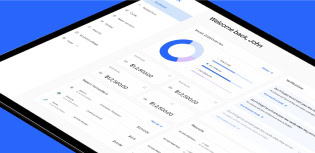PEX vs. Expensify: Why growing finance teams make the switch

Expensify has helped countless teams simplify receipt capture and reimbursements, especially for smaller businesses just starting to formalize their spend processes. But as companies grow, so do their financial management needs. What starts as simple expense tracking evolves into complex spend control, real-time visibility requirements, and the need for proactive financial management.
That’s where the fundamental differences between Expensify and PEX become clear. While both are established platforms serving businesses of all sizes, they take distinctly different approaches to expense management, and those differences matter more as your business scales.
Understanding the core philosophy: reactive vs proactive
Expensify excels at post-spend management. Employees submit receipts, managers approve them, and finance teams process reimbursements. This reactive approach works well for straightforward expense reporting needs.
PEX focuses on proactive spend management through real-time controls, multiple card options, and automated workflows that prevent issues before they happen. Rather than managing expenses after they occur, PEX helps finance teams control spending as it happens.
Here are four reasons why companies are making the switch from Expensify to PEX:
4 reasons to upgrade from Expensify to PEX
1. Real-time spend visibility vs. delayed reporting
The Expensify challenge: The Expensify challenge: Most workflows rely on employee-initiated reimbursement, which creates delays between when money is spent and when finance teams gain visibility. This lag limits your ability to intervene mid-spend or catch policy violations in real time.
The PEX advantage: Corporate cards with built-in spend controls provide immediate transaction visibility. You see spending as it happens, not weeks later when reports are submitted. This real-time insight enables proactive financial management and faster decision-making.
2. Preventive controls vs. post-transaction policy enforcement
The Expensify approach: Policy enforcement typically happens after transactions occur, during the approval process. While effective for compliance, this reactive approach can lead to budget overruns and uncomfortable conversations about out-of-policy spending.
The PEX solution: Customizable spend rules prevent out-of-policy transactions before they happen. Set merchant restrictions, transaction limits, and approval workflows down to the department or individual cardholder level. This proactive approach eliminates policy violations rather than just catching them.
3. Productivity that pays off
PEX customers report saving hundreds of hours annually by eliminating manual data entry, GL coding, and chasing receipts, freeing up time for more strategic work. PEX customers see $35K in labor savings/year based on internal time tracking and accounting benchmarks. While Expensify supports receipt capture and coding, it doesn’t automate key accounting workflows to the same extent or eliminate reimbursement processing altogether.
4. PEX provides industry-specific advantages
- Small to mid-market businesses: PEX’s scalable platform grows with your business, offering enterprise-level controls without enterprise complexity
- Nonprofits: Robust reporting for grant compliance, fund restriction management, and the transparency that pre-funded cards provide for donor accountability
- Construction and field services: Immediate fund access for materials and supplies, with real-time tracking across multiple job sites and locations
- Professional services: Project-based spending controls with detailed reporting for client billing and internal cost allocation
Why PEX is built for control where Expensify falls short
Expensify offers helpful features like:
- Integrations with accounting software like NetSuite
- Mobile receipt capture and easy user interface
- Custom cardholder groups and categories
- Multi-domain card management
- 24/7 customer support
But for finance leaders managing fast-moving teams, those features aren’t always enough.
Here’s where Expensify frequently causes friction:
- No automated monthly report cutoff: Some users report that unapproved expenses keep rolling into open reports, making month-end a manual mess
- Limited approval flexibility: Some users report limitations around multi-level approval workflows, depending on the plan tier or how their Expensify account is configured around multi-level approval workflows, depending on plan or configuration
- Transaction delays via bank feeds: Users have reported 3–5 day sync lags, based on online reviews and community feedback, which delay visibility and closeouts
- Duplicate entries from mobile capture: According to some users, manually uploaded receipts may mismatch with bank data, leading to reconciliation issues. On Expensify’s higher-level Collect and Control plans, Expensify will flag duplicate transactions, but managers still have to delete the duplicates themselves.
- Visibility gaps for approvers: You can set up multi-step approvals, similar to how you can set them up in PEX. However, in Expensify, assigned approvers may be unable to view transactions until they’re submitted, which slows accountability
Why finance leaders pick PEX over Expensify
- Virtual cards for tighter controls: Issue single-use or vendor-specific virtual cards to control subscriptions, travel or T&E spend at the source
- Seamless mobile capture included – no extra cost required: Users can take a photo of their receipt. Then, users have the option to text or email the receipt to PEX, or upload it straight to the app. From there, PEX will use AI to scan the receipt and auto-match it to the appropriate transaction, eliminating duplicate submissions.
- Over 50+ accounting software integrations: Sync seamlessly with systems like QuickBooks, NetSuite and Sage Intacct, without middleware or custom coding, at no additional cost
- No reimbursement issues: Use corporate cards (check out our Prepaid Expense or Credit Expense products) giving you more flexibility while eliminating out-of-pocket spend and reimbursement processing altogether
- Custom dashboards: Manage spending across departments and locations from one central interface
- Support that scales with you: Access live support and onboarding help designed for finance teams
“PEX enabled us to eliminate 93% of our reconciliation time. That’s not a typo,”
Family in Christ Community Church
Making the decision: Expensify vs. PEX
There are lots of great reasons to choose either Expensify or PEX, but the choice between Expensify and PEX often comes down to your organization’s growth stage and financial management philosophy:
Choose Expensify if:
- Your primary need is straightforward expense reporting and reimbursement
- You have simple approval workflows with minimal complexity
- Post-spend visibility and control are sufficient for your business needs
- You prefer the reimbursement model over corporate card programs
Choose PEX if:
- You need real-time spend visibility and proactive controls
- Your approval workflows require multiple levels or complex rules
- You want to eliminate reimbursement processing and out-of-pocket employee spending
- Time savings and process automation are priorities for your finance team
- You need flexible card options for different spending scenarios
- You are sick of chasing receipts and want your expense management platform to do it instead
What PEX customers say about us
“PEX has provided a great option for our organization to implement spend cards that sync automatically into our accounting software with associated tagging. They continue to innovate with the use of AI for process efficiency.[…] I like that most of the admin process is self service so I can quickly meet our staff’s needs.”
Alicia A., G2 reviewer
G2 reviewer
“[…] Previously, we had to wait until the end of the month for credit card reconciliations to understand spending. Now, we can see transactions as they happen, which has greatly enhanced our ability to manage budgets proactively. […] PEX has made our expense management more efficient, transparent, and user-friendly.”
The bottom line
Both Expensify and PEX serve important roles in business expense management, but they’re designed for different stages of business growth and financial management sophistication. Expensify excels at making expense reporting simple and user-friendly. PEX is built for finance teams that need comprehensive spend control, real-time visibility, and measurable productivity gains.
If your team is spending significant time on manual tasks, struggling with policy enforcement, or finding that your current tools aren’t keeping pace with your growth, it may be time to evaluate whether a proactive spend management approach like PEX could better serve your needs.
The best way to determine fit is to see how each platform handles your specific workflows and requirements.
Ready to see the difference for yourself? Book a personalized demo and find out how PEX can help your finance team save time, cut costs and work smarter not harder.
Disclaimer: This comparison is based on publicly available information and user-reported feedback as of the time of writing. Features, pricing and integrations may change. For the most current information, we recommend reaching out to both vendors directly.
Similar resources
Opinions, advice, services, or other information or content expressed or contributed here by customers, users, or others, are those of the respective author(s) or contributor(s) and do not necessarily state or reflect those of The Bancorp Bank, N.A. (“Bank”). Bank is not responsible for the accuracy of any content provided by author(s) or contributor(s).








